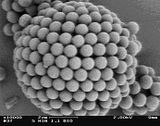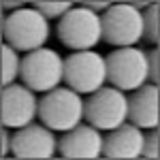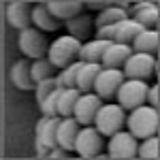Nano Materials
Applying the principle of self-assembly, we are able to build new materials, which are promising for biomedical application such as drug delivery vehicles. But they also address fundamental physical questions. Digital imaging analysis allows the study of the underlying physical processes involved in the self-assembly of particles at fluid -fluid interfaces, as well as the inter-particle forces on these interface.
By emulsifying a waterdroplet in an organic solvent (oil), which contains colloidal particles, a so called 'colloidosome' is produced. Because of the minimization of the overall interfacial energy, the colloidal particles cover the oil-water interface. For high enough volume fraction in the initial solvent, this results in a dense coverage with particles and therefore in a colloidal capsule with defined hole size and diameter.



Scanning electron microscope image of a dried, 10-mm-diameter colloidosome composed of sintered polystyrene spheres (450nm radius). The holes between the particle are about 300nm and thus the colloidosomes can be used as sieves for different biophysical application.